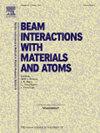NXSIM: A normalized XRF standardless iterative simulation method for qualitative and quantitative XRF analysis via MCNP
IF 1.4
3区 物理与天体物理
Q3 INSTRUMENTS & INSTRUMENTATION
Nuclear Instruments & Methods in Physics Research Section B-beam Interactions With Materials and Atoms
Pub Date : 2025-05-16
DOI:10.1016/j.nimb.2025.165739
引用次数: 0
Abstract
A normalized XRF standardless iterative simulation method (NXSIM) is proposed. Various methods are available to perform quantitative analysis with the XRF method. Many of these methods have laborious and costly processes that require sample preparations, specific reference materials, and repeated measurements. For such reasons, researchers continue to search for methods that provide more accurate and faster results. The main goals of this study are to obtain much faster results with acceptable accuracy by eliminating the need for repeated experimental measurements and reference samples. In this study, XRF spectrometry simulations were carried out with the scattering geometry designed in the MCNP 6.2 code system. The obtained results were used to perform quantitative analysis for experimentally prepared samples. After six samples with different element content and composition were prepared by the press pellet method, XRF spectra were obtained experimentally. Simulations were run with random element weight percentages using the elements in the sample. The elemental compositions of the samples were determined by the iteration method developed from the simulation results and experimental results. According to the results obtained, it has been demonstrated that XRF quantitative analysis can be performed by NXSIM with acceptable precision and accuracy.
NXSIM:一种标准化的XRF无标准迭代模拟方法,用于通过MCNP进行定性和定量的XRF分析
提出了一种归一化XRF无标准迭代仿真方法。有多种方法可用于XRF方法的定量分析。许多这些方法都有费力和昂贵的过程,需要样品制备,特定的参考物质和重复测量。由于这些原因,研究人员继续寻找提供更准确和更快结果的方法。本研究的主要目标是通过消除重复实验测量和参考样本的需要,以可接受的精度获得更快的结果。本文利用MCNP 6.2编码系统中设计的散射几何结构进行了XRF光谱模拟。所得结果用于实验制备样品的定量分析。采用压球法制备了6种不同元素含量和组成的样品,实验得到了样品的XRF光谱。使用样本中的元素随机进行元素权重百分比模拟。根据模拟结果和实验结果,采用迭代法确定了样品的元素组成。结果表明,NXSIM可以进行XRF定量分析,具有可接受的精度和准确度。
本文章由计算机程序翻译,如有差异,请以英文原文为准。
求助全文
约1分钟内获得全文
求助全文
来源期刊
CiteScore
2.80
自引率
7.70%
发文量
231
审稿时长
1.9 months
期刊介绍:
Section B of Nuclear Instruments and Methods in Physics Research covers all aspects of the interaction of energetic beams with atoms, molecules and aggregate forms of matter. This includes ion beam analysis and ion beam modification of materials as well as basic data of importance for these studies. Topics of general interest include: atomic collisions in solids, particle channelling, all aspects of collision cascades, the modification of materials by energetic beams, ion implantation, irradiation - induced changes in materials, the physics and chemistry of beam interactions and the analysis of materials by all forms of energetic radiation. Modification by ion, laser and electron beams for the study of electronic materials, metals, ceramics, insulators, polymers and other important and new materials systems are included. Related studies, such as the application of ion beam analysis to biological, archaeological and geological samples as well as applications to solve problems in planetary science are also welcome. Energetic beams of interest include atomic and molecular ions, neutrons, positrons and muons, plasmas directed at surfaces, electron and photon beams, including laser treated surfaces and studies of solids by photon radiation from rotating anodes, synchrotrons, etc. In addition, the interaction between various forms of radiation and radiation-induced deposition processes are relevant.

 求助内容:
求助内容: 应助结果提醒方式:
应助结果提醒方式:


